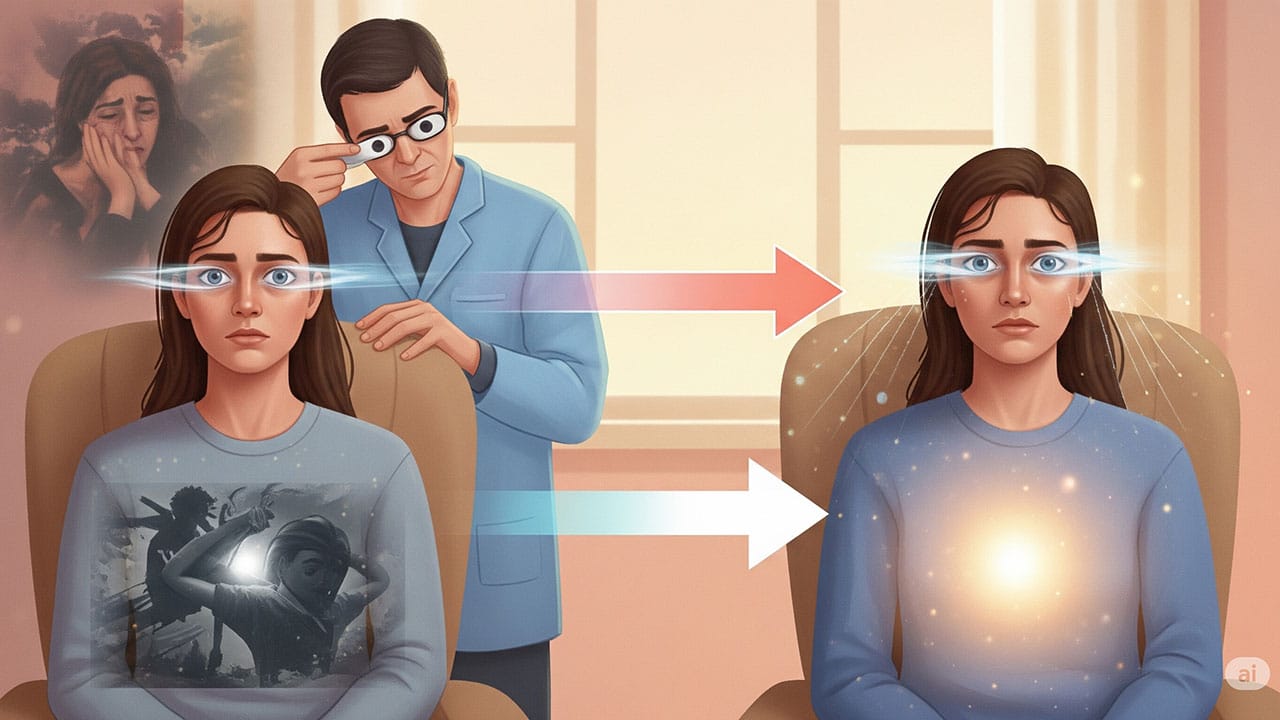
Healing Hidden Wounds: A Compassionate Look at EMDR Therapy

Life’s journey, while beautiful, can sometimes leave us with deeply etched imprints of distressing experiences. These aren’t just memories; they’re echoes that ripple through our present, influencing our thoughts, feelings, and behaviors. For individuals seeking a path to release these echoes and find a renewed sense of peace, EMDR therapy stands as a highly effective and transformative approach.
Eye Movement Desensitization and Reprocessing (EMDR) is a psychotherapy designed to help people heal from the symptoms and emotional distress that are the result of disturbing life experiences. Unlike traditional talk therapy that might focus on prolonged discussion of traumatic events, EMDR therapy employs a unique, structured methodology to help the brain reprocess these memories, enabling individuals to move past their painful impact. It’s not about forgetting the past, but rather about integrating it in a way that no longer holds emotional power over the present.
Understanding the Core of EMDR: Adaptive Information Processing
The theoretical foundation of EMDR therapy is the Adaptive Information Processing (AIP) model. This model posits that our brains have a natural, innate capacity to process and integrate information. When a highly distressing or traumatic event occurs, this natural processing system can become overwhelmed, causing the memory to be “stuck” or maladaptively stored in the brain’s neural networks.
When a memory is “stuck,” it means that the original thoughts, emotions, sensations, and beliefs associated with the traumatic event remain vivid and disturbing, even years later. These unprocessed memories can feel as if they are happening in the present, leading to symptoms like flashbacks, nightmares, intense anxiety, or a persistent sense of fear. They can profoundly impact our perceptions of ourselves, others, and the world, often leading to negative self-beliefs (e.g., “I am not safe,” “I am not good enough,” “It was my fault”).
EMDR therapy aims to jumpstart this natural healing process. By using bilateral stimulation—typically guided eye movements, but sometimes alternating sounds or taps—it helps the brain resume its adaptive information processing. This unique element of EMDR is thought to facilitate communication between different parts of the brain, allowing the “stuck” memories to be reprocessed and integrated into a more functional and less distressing neural network. Essentially, it helps the brain “digest” the experience, much like the body digests food, so that what’s useful is learned and what’s unhelpful is discarded.
How Does EMDR Therapy Work? The Eight-Phase Protocol
EMDR therapy is not just about moving your eyes; it’s a comprehensive, eight-phase treatment approach guided by a trained therapist. Each phase serves a specific purpose in preparing the individual, processing the distressing memory, and integrating positive changes.
Phase 1: History-Taking and Treatment Planning
Your EMDR therapist will begin by taking a thorough history, understanding your current challenges, and identifying potential “target memories” for processing. This phase also involves establishing a strong therapeutic relationship and ensuring you are ready for the process.
Phase 2: Preparation
This crucial phase focuses on building internal resources and coping skills. Your therapist will explain the EMDR process in detail, teach you relaxation techniques, and help you develop strategies to manage any emotional distress that might arise during reprocessing. This ensures you feel safe and capable throughout the therapy.
Phase 3: Assessment
Once prepared, you and your therapist will select a specific target memory to work on. You’ll identify the vivid image that represents the worst part of the memory, the negative belief you hold about yourself in relation to it (e.g., “I am helpless”), and a desired positive belief (e.g., “I am capable now”). You’ll also identify the emotions and physical sensations associated with the memory, rating their intensity on scales (Subjective Units of Disturbance – SUD, and Validity of Cognition – VOC).
Phases 4-7: Desensitization, Installation, Body Scan, and Closure
These are the core reprocessing phases. While focusing on the distressing memory and negative belief, you’ll engage in bilateral stimulation (e.g., following your therapist’s fingers with your eyes, listening to alternating tones, or holding buzzers that vibrate left and right). During these sets of stimulation, you allow your mind to go wherever it needs to, noticing any thoughts, feelings, sensations, or images that arise without judgment.
The therapist guides you through repeated sets until your distress (SUD) related to the memory significantly decreases. Once the memory is desensitized, the installation phase begins, where the positive belief is strengthened while engaging in bilateral stimulation. A body scan then checks for any lingering tension or sensations in your body, and these are also addressed. Finally, the closure phase ensures you feel grounded and stable before ending the session, providing strategies to maintain calm between sessions.
Phase 8: Re-evaluation
At the start of subsequent sessions, your therapist will re-evaluate the progress made on previously processed memories, ensuring the distress remains low and the positive beliefs are stable. This phase also helps determine if further processing is needed or if new target memories should be addressed.
Who Can Benefit from EMDR Therapy? Beyond PTSD
While EMDR therapy was initially developed and is most extensively researched for Post-Traumatic Stress Disorder (PTSD), its application has broadened considerably. It is now recognized as an effective treatment for a range of mental health conditions and distressing experiences, including:
Trauma (Single Incident and Complex): Beyond traditional PTSD, EMDR is highly effective for various forms of trauma, including childhood abuse, neglect, car accidents, natural disasters, assault, and other emotionally overwhelming events.
Anxiety Disorders: This includes Generalized Anxiety Disorder, Panic Disorder, Social Anxiety Disorder, and specific phobias. EMDR for anxiety can help desensitize the underlying fears and reprocess experiences that contribute to anxious responses.
Depression: Often, depression can be linked to unresolved past experiences or negative self-beliefs. EMDR for depression can address these roots, leading to improved mood and self-esteem.
Obsessive-Compulsive Disorder (OCD): While not a primary treatment, EMDR can be a valuable adjunct for addressing underlying trauma or anxiety that contributes to OCD symptoms.
Eating Disorders: EMDR can help individuals process traumatic experiences related to food, body image, or control that may fuel disordered eating patterns.
Substance Use Disorders: By addressing the underlying trauma that often co-occurs with addiction, EMDR can support recovery.
Grief and Loss: Processing the intense emotions and memories associated with profound loss.
Chronic Pain: While not a cure for physical pain, EMDR can reduce the emotional distress and psychological impact associated with chronic pain conditions.
Performance Anxiety: Helping athletes, performers, or professionals overcome blocks rooted in past failures or anxieties.
The versatility of EMDR lies in its focus on how distressing experiences are stored and processed by the brain, making it applicable to any issue rooted in maladaptively stored memories.
The EMDR Journey: A Relatable Experience
For many individuals considering EMDR therapy, questions about the experience are natural. It’s a journey that can feel different from other therapies. While some sessions might involve discussing difficult memories, the core of the EMDR reprocessing involves less verbal recounting of the trauma itself. Instead, the focus is on the internal experience as your brain does the work of re-processing, guided by the bilateral stimulation.
Clients often report feeling a sense of release or a shift in perspective during or after EMDR sessions. Memories that once felt overwhelming or intensely emotional may begin to feel more distant, less vivid, or simply “in the past.” The negative beliefs associated with these memories may also transform into more positive and empowering ones. This often happens organically, without conscious effort to “think differently.”
It’s common to feel tired or experience vivid dreams after an EMDR session as your brain continues to process. A good therapist will always prioritize your safety and well-being, ensuring you have coping strategies for any discomfort between sessions. The goal is always to move towards a place of healing and resilience, not to re-traumatize.
Finding an EMDR Therapist in North Carolina: Your Path to Healing
North Carolina, with its diverse communities from the Appalachian Mountains to the Outer Banks, offers numerous opportunities to connect with qualified EMDR therapists. Finding the right professional is a crucial step in your healing journey.
Key Qualifications for an EMDR Therapist
When seeking an EMDR therapist, it’s essential to look for specific qualifications to ensure you receive ethical and effective treatment:
Licensure: Ensure the therapist is a licensed mental health professional in North Carolina (e.g., Licensed Psychologist, Licensed Clinical Social Worker (LCSW), Licensed Professional Counselor (LPC), Licensed Marriage and Family Therapist (LMFT)).
EMDRIA Approved Training: The gold standard for EMDR therapy training is through the EMDR International Association (EMDRIA). Look for therapists who have completed an EMDRIA-approved basic training, and ideally, those who are EMDRIA Certified Therapists or Approved Consultants. This signifies a higher level of training, consultation, and adherence to EMDRIA’s rigorous standards.
Experience: Inquire about their experience working with your specific concerns (e.g., complex trauma, anxiety, phobias).
Therapeutic Fit: Beyond credentials, the relationship you have with your therapist is paramount. Look for someone with whom you feel comfortable, safe, and understood. Many therapists offer brief introductory calls to assess this fit.
Resources for Finding EMDR Therapists in North Carolina
EMDRIA Find a Therapist Directory: The official EMDRIA website offers a searchable directory of EMDRIA members who provide EMDR therapy. You can filter by location (city, state, zip code), certification level, and other criteria. This is often the most reliable place to start.
Psychology Today: This widely used online directory allows you to search for therapists by location, insurance, and therapy type, including EMDR. You can read therapist profiles and often contact them directly.
Professional Referrals: Your primary care physician or other mental health professionals can often provide referrals to trusted EMDR therapists in your area of North Carolina.
University Medical Centers: Major university health systems like Duke Health in Durham or UNC Health in Chapel Hill may have clinics or departments specializing in trauma and EMDR therapy.
Local Mental Health Organizations: Community mental health centers or local mental health associations in North Carolina might offer resources or referrals, sometimes at reduced costs.
When contacting potential therapists, don’t hesitate to ask about their EMDR training, their approach, and how they handle specific issues relevant to you.
Embracing a Future of Healing and Resilience
The journey of healing from distressing past experiences is profoundly personal, and EMDR therapy offers a powerful beacon of hope. It’s an active process that respects your brain’s natural capacity to heal, providing the structure and guidance to facilitate that healing. For those in North Carolina grappling with the lingering effects of trauma, anxiety, or other emotional burdens, exploring Eye Movement Desensitization and Reprocessing can be a profound step towards regaining control, finding inner peace, and embracing a future marked by resilience and well-being. You deserve to move forward, and with the right support, that path is within reach.
Schedule a free 15-minute call to see if we are a good fit.

Contact Us

